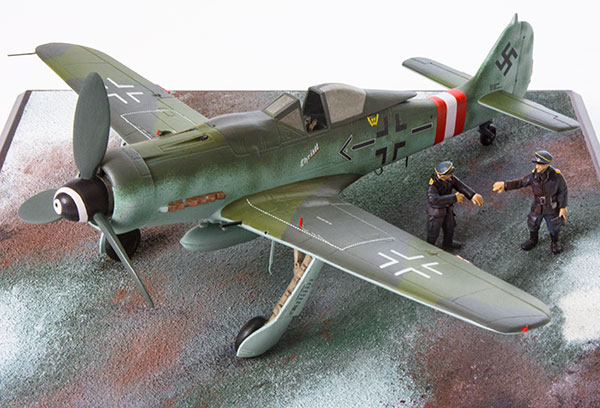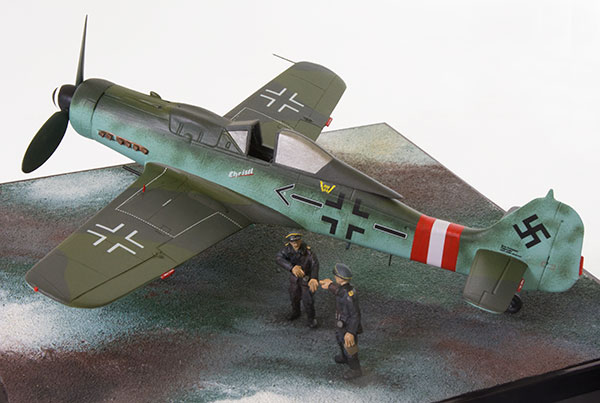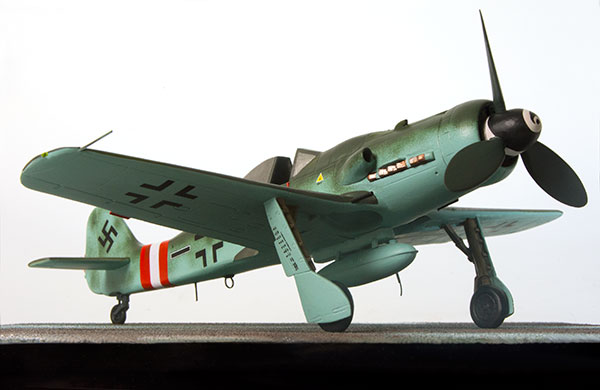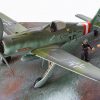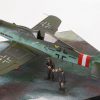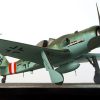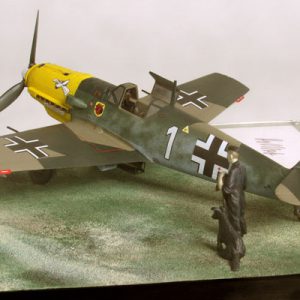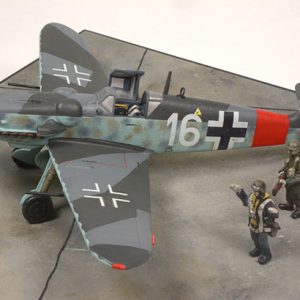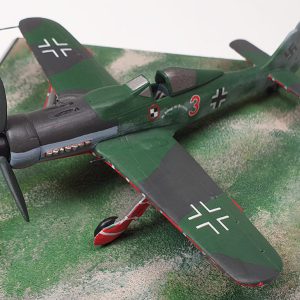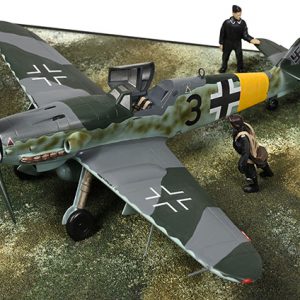Focke Wulf Fw 190D-9, <-+- ‘Christl’, JG 6
Kommodore Gerhard Barkhorn, February 1945.
The Focke-Wulf Fw 190D (“Dora”), which entered service in autumn 1944, was the last variant of Kurt Tank’s Fw 190 to see service in considerable numbers. References cite that between 650 and 700 “Doras” were built before the occupation of Focke-Wulf factories by Allied forces brought production to an end. Early in development, Tank began addressing the limitations, at higher altitude, of the original BMW radial-engined Fw 190A. The main issue with the radial power plant was its poor performance above 23,000ft. In the long-nosed Fw 190D-9 variant, the BMW 801 radial unit of earlier types was superseded by a Junkers Jumo 213 liquid cooled in-line engine driving a three-bladed “paddle” propeller. A supercharger powered mechanically by the engine and water-methanol injection aided further improvements to performance. These power plant changes resulted in an aircraft with a top speed of 426mph and a service ceiling of 43,000ft. Armament comprised two 20mm MG 151 cannons in the wings and two 13mm MG 131 machine guns above the engine, plus one 1,102lb bomb on a centreline ventral rack. Alternatively a 300l drop tank could be carried on the centreline unit to extend flying time. The “Dora” could out-climb and out-dive its BMW radial-powered predecessor with ease, and it possessed an excellent turning rate at speed. An experienced pilot could pull a tighter turn in a Fw 190D-9 than he could with the Fw 190A. Many who flew the Fw 190D-9 considered it one of the finest propeller-driven fighters available to the Luftwaffe, showing comparable performance with the Spitfire XIV and Mustang P-51D.
Gerhard “Gerd” Barkhorn, was born on 20th March 1919 in Königsberg. Barkhorn joined the Luftwaffe in 1937 and completed his training in 1939. Barkhorn flew his first combat missions in May 1940, during the Battle of France. He participated in the Battle of Britain without scoring an aerial victory. Following the invasion of Russia, his first kill came in July 1941 when he shot down a Soviet Ilyushin DB-3 bomber. Thereafter his total score rose steadily against red air force opposition. As a fighter pilot, Barkhorn was no long-range deflection shooter in the style of Marseilles or Rall, neither was he a close proximity ambusher like Krupinski or Hartmann. He raised his score, through constant dedication and skill as a dogfighter. In March 1944 he was awarded the Knight’s Cross with Oak Leaves and Swords. Barkhorn flew 1,104 combat sorties and was credited with 301 aerial victories on the Eastern Front piloting the Messerschmitt Bf 109 and Fw 190D. On 5th January 1945, whilst flying with Jagdgeschwader 52 (JG 52), he downed his last Soviet aircraft, a Lavochkin LaGG-5 fighter plane. Besides Eric Hartmann, Barkhorn was the only pilot ever to break the triple-century for number of aircraft shot down. On the 16th of January 1945, Barkhorn was assigned as Geschwaderkommodore to Jagdgeschwader 6 (JG 6) “Horst Wessel”, a unit defending the Reich and equipped with the Fw 190D (although he also elected to retain his Messerschmitt Bf 109G). JG 6 was a unit consisting mostly of new recruits and former Messerschmitt Bf 110 pilots. It suffered heavy losses against the American air fleets and had lost both personnel and machines in Operation Bodenplatte on New Year’s Day. JG 6’s first Fw 190D-9’s were operational at the end of January 1945. Later that month, JG 6 was among several units switched to the Oder Front, flying ground strafing operations against the advancing Soviet forces. By the middle of April 1945, Barkhorn had left JG 6 and joined Adolf Galland’s elite Jagdverband 44 (JV 44) flying the Messerschmitt Me 262 jet fighter. On 21st April 1945, he flew his 1,104th and last mission.
Barkhorn survived the war, was taken prisoner by the Western Allies in May 1945 and released later that year. Post 1945, Barkhorn joined the Luftwaffe of the Bundeswehr, serving until 1976. On 6th January 1983 Barkhorn, and his wife Christl, were involved in a fatal car crash during a snowstorm. Barkhorn’s Fw 190D-9 was painted RLM colours 81/82/76 with mottling on the upper surface of its fuselage. A single chevron denoted his rank as Kommodore of JG 6. Markings for defence of the Reich duties were formalized in February 1945 and JG 6 was assigned a red/white/red Reichsverteidigung band. As on his previous mounts, a salutation to his wife Christl was carried below the aircraft’s canopy


